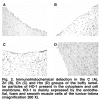Effect of the haeme oxygenase-1/endogenous carbon monoxide system on atherosclerotic plaque formation in rabbits
- PMID: 20972512
- PMCID: PMC3721901
- DOI: 10.5830/cvja-2010-015
Effect of the haeme oxygenase-1/endogenous carbon monoxide system on atherosclerotic plaque formation in rabbits
Abstract
Background: To investigate the effect of the haeme oxygenase-1/carbon monoxide (HO-1/CO) system on atherosclerotic plaque formation and its possible mechanism.
Methods: For 12 weeks, rabbits were given a 1.5% cholesterol diet (Ch group, n = 8) or a 1.5% cholesterol diet plus an HO-1 inducer, haemin (Hm group, n = 8), or an HO-1 inhibitor, zinc protoporphyrin IX (Znpp-IX, Zn group, n = 8) by intraperitoneal injection.
Results: Compared with the normal control group (C group, n = 8), serum levels of lipids and oxidised low-density lipoproteins (ox-LDL) increased significantly in all experimental groups (p < 0.01). However, no significant differences were observed among the three experimental groups (p > 0.01). Compared with the control group, aortic nitric oxide (NO) production and nitric oxide synthase (cNOS) activity decreased markedly, whereas carbon monoxide (CO) production and HO-1 activity increased markedly in the Ch group (p < 0.01). This was associated with an increase in the area of aortic plaque of 54.00 ± 4.16%. Compared with the Ch group, CO production and HO-1 activity increased markedly, while aortic HO activity and CO production decreased significantly in the Hm group. The area of aortic plaque was significantly reduced in the Hm group (17.88 ± 3.01%), whereas the area of aortic plaque was significantly increased in the Zn group (61.13 ± 3.50%). Compared with the Ch group, aortic endothlin-1 expression in the Hm group reduced significantly, while in the Zn group it was significantly higher than in the Ch group (p < 0.01).
Conclusion: The HO-1/CO system plays an inhibitory role in atherosclerotic plaque formation. This role was not mediated by regulating serum lipids and ox-LDL, but was related to the reciprocal relationship between the HO-1/CO and NOS/NO systems in atherosclerosis and the down-regulated expression of endothlin-1 (ET-1), which inhibits the proliferation of vascular smooth muscle cells.
Figures





Similar articles
-
[Prevention of atherosclerotic plaque development by modulating heme oxygenase-1-endogenous carbon monoxide system in rabbit model].Zhonghua Bing Li Xue Za Zhi. 2011 Jun;40(6):397-402. Zhonghua Bing Li Xue Za Zhi. 2011. PMID: 21914349 Chinese.
-
[Change and correlation of heme oxygenase/carbon monoxide and nitric oxide synthase/nitrogen monoxide system in atherosclerotic progress of rabbits].Zhonghua Xin Xue Guan Bing Za Zhi. 2005 Apr;33(4):354-9. Zhonghua Xin Xue Guan Bing Za Zhi. 2005. PMID: 15932671 Chinese.
-
Effects of induction/inhibition of endogenous heme oxygenase-1 on lipid metabolism, endothelial function, and atherosclerosis in rabbits on a high fat diet.J Pharmacol Sci. 2012;118(1):14-24. doi: 10.1254/jphs.11071fp. J Pharmacol Sci. 2012. PMID: 22261087
-
Carbon monoxide is a major contributor to the regulation of vascular tone in aortas expressing high levels of haeme oxygenase-1.Br J Pharmacol. 1998 Dec;125(7):1437-44. doi: 10.1038/sj.bjp.0702212. Br J Pharmacol. 1998. PMID: 9884071 Free PMC article.
-
The role of carbon monoxide in the gastrointestinal tract.J Physiol. 2004 Apr 15;556(Pt 2):325-36. doi: 10.1113/jphysiol.2003.056556. Epub 2004 Feb 6. J Physiol. 2004. PMID: 14766943 Free PMC article. Review.
Cited by
-
Mechanistic insights into the anti-restenotic effects of HSP27 and HO1 modulated by reconstituted HDL on neointimal hyperplasia.Sci Rep. 2023 Dec 12;13(1):22078. doi: 10.1038/s41598-023-49367-9. Sci Rep. 2023. PMID: 38087008 Free PMC article.
-
Carbon monoxide promotes respiratory hemoproteins iron reduction using peroxides as electron donors.PLoS One. 2012;7(3):e33039. doi: 10.1371/journal.pone.0033039. Epub 2012 Mar 12. PLoS One. 2012. PMID: 22427940 Free PMC article.
References
-
- Tulis DA, Durante W, Peyton KJ. Heme oxygenase-1 attenuates vascular remodeling following ballon injury in rat carotid arteries. Atherosclerosis. 2001;155:113–122. - PubMed
-
- Togane Y, Morita T, Suematsu M. et al. Protective roles of endogenous carbon monoxide in neointimal development elicited by arterial injury. Am J Physiol Heart Circ Physiol. 2000;278:H623–632. - PubMed
-
- Christodoulides N, Durante W, Kroll MH. et al. Vascular smooth muscle cell heme oxygenases generate guanylyl cyclase stimulatory carbon monoxide. Circulation. 1995;91:2306–2309. - PubMed
-
- Beltowski J, Jamroz A, Borkowska E. Heme oxygenase and carbon monoxide in the physiology and pathology of the cardiovascular system. Postepy Hig Med Dosw. 2004;58:83–99. - PubMed
-
- Green LC, Wagner DA, Glogowski J. et al. Analysis of nitrate, nitrite and [15N] nitrate in biological fluids. Anal Biochem. 1982;126:131–138. - PubMed
Publication types
MeSH terms
Substances
LinkOut - more resources
Full Text Sources
Other Literature Sources

